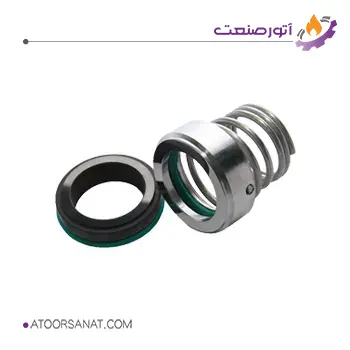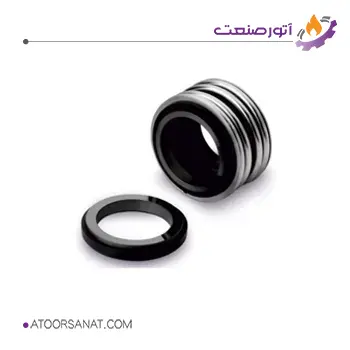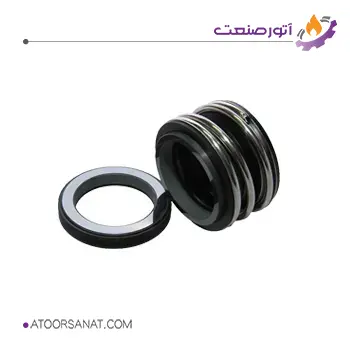Mechanical Seal

What is a Mechanical Seal?
A mechanical seal is a simple method of containing fluid within a chamber through which a rotating shaft passes. This method is familiar in almost all industrial societies, and wherever there is a rotating shaft, some form of sealing is required.

Features:
- Materials: Stainless Steel 316 / Carbon / Viton
- Maximum Operating Pressure: 12 bar
- Applications: For sealing various types of pumps.
Features:
- Materials: Silicon / Viton
- Maximum Operating Pressure: 10 bar
- Applications: For sealing various types of pumps.

Features:
- Materials: Tungsten / Viton
- Minimum Size: 12 mm
- Applications: For sealing various types of pumps.

Features:
- Country of Origin: Germany
- Maximum Operating Pressure: 12 bar
- Applications: For sealing various types of pumps.
Mechanical Seal Operation
Mechanical seals are used in systems that require the containment of fluid within a chamber, and this chamber is usually associated with pumps and mixers. For example, in sealing a centrifugal pump, the challenge is to allow a rotating shaft to enter the wet part of the pump without a large volume of high-pressure water escaping from the chamber. To address this challenge, a sealing system must exist between the shaft and the housing to withstand fluid pressure and tolerate the friction caused by shaft rotation.
A mechanical seal consists of two basic parts: one part is stationary and the other rotates to achieve the sealing goal. Several simple mechanisms and various components are used for the operation of a mechanical seal and its connection to the shaft and stationary part. Mechanical seals are usually of the stationary surface or rotating surface type, but in some designs, ambient and double-lip seals are also used. In all cases, the use of the following components for sealing is common:
- Primary rotating sealing element: This element is attached to the shaft and is rotated by it, and is opposite to the primary stationary sealing element.
- Primary stationary sealing element: This element is attached to the stationary housing of the pump, mixer, or other device and exerts force on the primary rotating sealing element.
- Collecting force: This force is applied to the sealing elements to keep the elements together and ensure sealing.
- Secondary stationary and moving seals: Sealing between the mechanical seal components and the shaft and housing equipment
A simple seal has three parts. The stationary part of the seal is located on the stationary housing, and an O-ring or washer can also be placed between the stationary and moving parts.
One part of the system, which can be either moving or stationary, is always installed flexibly, and a spring is provided to compensate for any deformation in the shaft and its movement due to bearing tolerances and shaft misalignment. While two parts of the mechanical seal components are stationary, the part between the stationary housing and the moving shaft requires more attention. This part is the main part of the entire design, and its proper functioning is essential for the system’s efficiency.
In common mechanical seal designs, the primary sealing elements are in contact with each other. Rings made of ceramic, carbide, carbon, or composite are used in these elements. The sealed fluid moves between the faces of the primary elements and forms a stable layer between the two elements.
When the shaft rotates, the sealing elements will heat up and wear out quickly without a cooling fluid. The sealed fluid creates a thin layer of lubrication. In the lip-type mechanical seal, a thin layer of the sealed fluid cools the sealing interface.
The choice of material for the primary sealing elements has a significant impact on the life of the system. Chemical compatibility is only one of the selection criteria. Harder materials are more resistant to corrosive fluids, but if both elements are made of hard materials, the wear between them will also increase, and they will not be suitable for non-corrosive fluids.
Using a softer or lubricated material such as graphite will reduce friction and loss. Also, the use of hard composite materials reduces friction by providing microscopic pores on the contact surface of the elements.
Another feature considered when selecting the material of the elements is thermal conductivity, which transfers heat away from the contact surface. The surface hardness of the elements and the internal texture of the materials also play a significant role in the life of the seal. Keep in mind that many seal failures are due to the failure of the secondary seal due to unfavorable chemical conditions, pressure, and temperature. Metal parts must also be compatible with the type of fluid to avoid corrosion.
Types of Mechanical Seals
Mechanical seals differ in design, component arrangement, and the mechanism for dissipating the force applied to the surfaces. There are several common types of mechanical seals, including:
- Balanced mechanical seal: This type refers to a system in which the forces applied to the sealing surfaces are neutralized. Due to the low force on the sealing elements, lubrication on the surfaces is homogeneous, and as a result, the life of this type of seal is long. Balanced mechanical seals are suitable for high-pressure applications (above 14 atmospheres) and are also a good choice for fluids with low lubricity.
- Unbalanced mechanical seal: This type of mechanical seal is an economical choice and has less leakage due to the higher force on the surfaces. On the other hand, the life of an unbalanced mechanical seal is shorter. This option is suitable for low pressures and is not recommended for hydrocarbons.
- Spring-loaded mechanical seal: In this type, one or more springs are used to create a collecting force. Springs can be located in stationary or moving elements. Spring-loaded seals can be used for high pressures but have high wear due to the elastomer located below the primary sealing surface.
- Springless mechanical seal: In this type, a metal or elastomer is used to create a collecting force. Springless mechanical seals are suitable for applications with high temperatures and contaminated fluids, and their suitable operating range is low to medium pressure. Both spring-loaded and springless designs can be balanced or unbalanced.
- Cartridge mechanical seal: In this type, all parts are assembled in a single unit, which reduces the probability of assembly errors and increases the seal replacement time.

